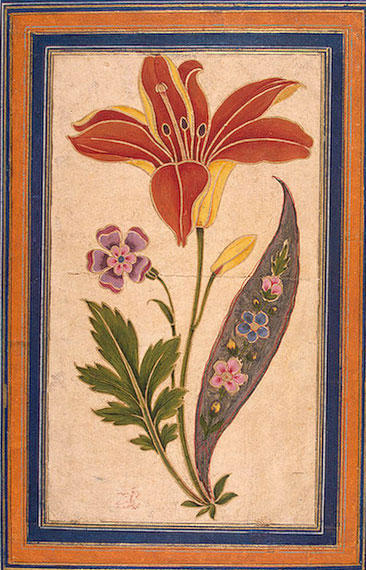trinity flowers
In a recent post titled the forgotten cup (and expanded into an article titled The Forgotten Cup), I was exploring parallels between Judaic, Christian and Islamic themes relating to the triune nature of deity. Orthodox Islam does not, of course, recognize any Divine Trinity and, indeed, quite specifically and emphatically denies its validity. However, this theme is an archetypal one, embedded in the very nature of the human psyche and its mythopoetic imagination. Somehow or other, the Divine Trinity must express itself, even within Islamic culture and especially within Islamic arts. An exquisite example of this is shown below:

Muhammad Mahdi: Flower Study, Iran c.1750 @ State Hermitage Museum
The main flower in this arrangement is a red and yellow iris. In its commentary on this painting, the State Hermitage Museum explains:
The iris, for instance, was a holy flower of Islam - some of its leaves point upwards towards Allah, while others drop down towards the earth; yet others are level, as if indicating Man himself.
Already, the symbolic significance of this flower has a three-fold aspect: Heaven above, Earth below, and Humanity in between. However, the trinity is further emphasized in the three stamens that surround the central pistil of the flower. In an odd reversal of usual sexual symbolism the central pistil is the female part of the flower despite its evident phallic shape. As a symbolic feature, it represents the Unity inside the Trinity and is a close parallel to the central and containing cup already discussed. Archetypal symbols have this tendency to shift from masculine to feminine and back again almost like a breathing in and a breathing out.
The main iris flower is depicted in a very naturalistic manner, quite resembling an illustration in a scientific work on botany. However, that is where the naturalism ends. The leaves emerging from the left-most stem are also naturalistic in shape but they are not iris leaves. My own botanical knowledge is too limited for me to recognize the plant but I do know that iris leaves are more grass-like or sword-like, highly elongated and nothing like the leaves depicted here. They do bear a resemblance to celery leaves or to the leaves of some herbs like flat-leaf parsley. They may be intended as a contrast to the flower that pleases the eye while this plant pleases the palate.
The group, then, contains two naturalistic elements but belonging to two different plant species. A third element, the flower between the herb and the iris, is a decorative fancy, an almost abstract mandala, though it closely resembles a naturalistic flower. Again, my botanical knowledge is limited but I very much doubt that there exists in nature a flower with five outer and six inner petals as this one displays. My guess is that it is a transitional symbol, bridging the natural and the abstract, and thus again bridging the earth and the heavens.
Finally, there is the long flat leaf at the right of the composition. This can no longer have any pretense to being naturalistic, it is frankly symbolic. It seems to be the final abstract point resulting from a meditation on the actual iris flower and herb. Here, the unity expresses itself primarily in its overall containing aspect, the envelope or larger container of the trinity, rather than as a central nub (the smaller cup in the Russian icon discussed previously). The three flowers within this arrangement sit like peas in a pod, a quite unnatural placement. The flower colours are also alternating from pink (for girls?) to blue (for boys?) and back to pink again.
Christian icons of the type of the Russian icon of the trinity are designed to provide a window into the world of the divine, the archetypal world within the human soul. Certainly, this small Islamic artwork (the original only about the size of an A4 sheet of paper) has this quality. As one enters it, one plunges into a veritable ocean of lively possibilities, a boundless meditation on three-ness, one-ness, nature, symbols, male-ness, female-ness, and much much more.
Labels: Archetypes, Trinity



4 Comments:
Beautiful article.
I just discovered your blog, I'll come back to stay longer.
Thank you
And thank you also for your appreciation. :)
You welcome. Please keep on writing and sharing your thoughts with us. I wonder if you knew Henry Corbin. You can check here : http://henrycorbinproject.blogspot.fr/
I also had a blog which is now closed. Maybe you would be interested (if you read french) :
http://forteresses.blogspot.fr/
And also, this one which I don't take care anymore :
http://leverdoyant.blogspot.fr/
I spent much time yesterday on your blog and will come back again to spend more time when I'll have more time :-/
Cheers
I have a little French but not enough to appreciate your blogs properly. There are beautiful images and poetry there, I can see we have similar tastes in art.
Post a Comment
<< Home